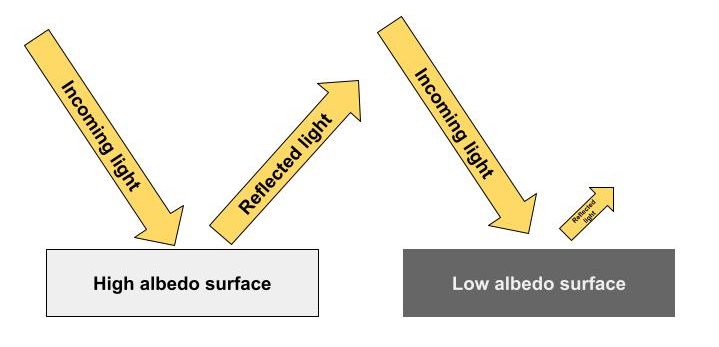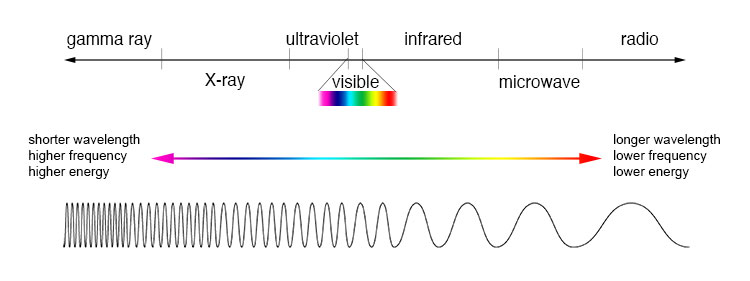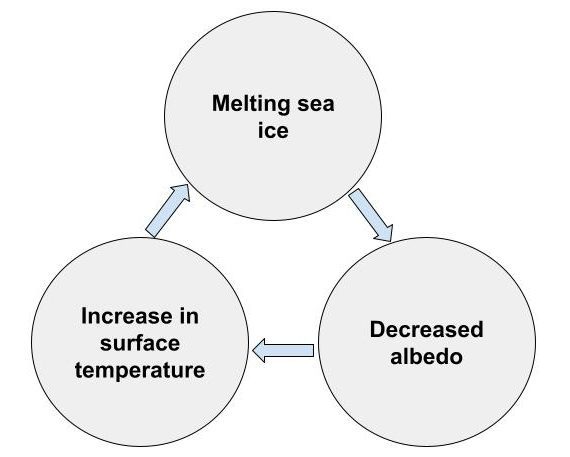1 Albedo & Climate Change
What is albedo?
When light hits a surface, it can either be reflected or absorbed. Albedo is used to describe how much light a surface reflects. Surfaces with high albedos reflect more light than surfaces with low albedos. On the other hand, surfaces with low albedos absorb more light than surfaces with high albedos. In most cases, dark surfaces tend to have low albedos, whereas light surfaces tend to have high albedos.

In Earth’s case, most of the light that hits our planet is emitted by the Sun. The Sun emits light at all wavelengths, which are broken down into categories on the electromagnetic spectrum. Very high energy light like gamma rays has a short wavelength and high frequency, whereas very low energy light like radio waves has a long wavelength and low frequency. The Sun emits most of its light as visible light, which is the light we can see, so most of the light that is absorbed or reflected by Earth is visible light.

Albedos of different surfaces
When sunlight reaches Earth’s surface, it is either reflected or absorbed. How much light is reflected or absorbed depends on two things: the albedo of the surface that the light hits and the wavelength of light. For our purposes, we will simply refer to the average albedo of a surface over all wavelengths. On average, Earth’s planetary albedo is 0.3. This means that about 30% of incoming light is reflected from Earth, whereas about 70% is absorbed. In reality, it is a bit more complicated. Each surface on Earth has a different albedo, which means each surface reflects a different amount of light. The chart below outlines average albedos of different natural surfaces on Earth.
| Surface | Albedo |
| Clouds | 0.1 – 0.9 |
| Grass | 0.25 |
| Forests | 0.08 – 0.18 |
| Sand | 0.40 |
| Sea ice | 0.5 – 0.7 |
| Sea water | 0.06 |
| Snow | 0.8 |
| Soil | 0.17 |
Sea water, soil, and forests have the lowest albedos, causing most of the absorption of incoming light. Sea ice, snow, and clouds have the highest albedos, reflecting most of the incoming light. Cloud cover also has a large effect on Earth’s albedo. Depending on thickness, size, and shape, clouds can reflect up to 90% of incoming light. Thick clouds tend to reflect more incoming light than thin clouds, indicating that they have a higher albedo than thin clouds.

Although thick clouds reflect most incoming light, they can also create a feedback effect by reflecting surface light back instead of letting it leave Earth’s system. On the other hand, light reflected by Earth’s surface is able to pass through thin clouds with little of the light reflected back.
Albedo and Earth’s changing climate
We learned that albedo is a measure of how much light is reflected by a surface: high albedo surfaces reflect more light than low albedo surfaces. We also learned that any light that is not reflected is absorbed by the surface. When light is absorbed by a surface, regardless of its albedo, the surface’s temperature increases. Because low albedo surfaces absorb more light than high albedo surfaces, though, the temperature of low albedo surfaces increases more than high albedo surfaces in the same amount of time. More simply – a decrease in albedo leads to a larger increase in surface temperature over time.
This can lead to what is known as a runaway feedback loop. In the case of Earth, we know that sea ice is one of the highest albedo, or most reflective, surfaces on the planet. As the planet warms because of an increase in carbon dioxide in our atmosphere from excess pollution, agricultural practices, and deforestation, sea ice melts into sea water. When this happens, Earth’s average albedo decreases: sea ice absorbs 30-50% of incoming sunlight, whereas sea water absorbs 94% of incoming sunlight. This drastic change in albedo leads to an increase in absorbed sunlight, which leads to an increase in Earth’s average temperature, which leads to more sea ice melting, and so on.

This runaway effect also explains why arctic regions on Earth are experiencing more significant changes in their climate than other areas. Because the albedo drastically decreases when sea ice melts, the amount of sunlight being absorbed in arctic regions is increasing more than other areas on the planet where the water is already in liquid form.
Climate Change & Wisconsin
Although the effects are more noticeable in Earth’s arctic regions, climate change affects the entire planet. In fact, a decrease in sea ice and resulting increase in temperature in the arctic caused by climate change impacts climates all over the planet. A particular example of this is the destabilization of the polar vortex. The polar vortex is a region of frigid cold air with low atmospheric pressure that typically stays over the North Pole. It is kept in place by the large temperature difference between the cold North Pole and warm equator. Because the arctic regions are warming faster than other regions on Earth, the temperature difference between the North pole and equator has decreased. This weakens the polar vortex and allows it to stray from the North Pole more frequently, bringing colder air to places much farther south, including Wisconsin. Although the air we feel in Wisconsin is much colder than usual when the polar vortex strays from the North Pole, it is actually the warming of the arctic that causes the weather here in Wisconsin to change. This change in the polar vortex also destabilizes the jet stream, causing more extreme weather events.
Over the past 150 years, there has been a decrease in the number of days Lake Mendota and Lake Monona are covered in ice over the winter. Lake Mendota has an average of 31 fewer days of ice cover over the winter compared to 1855, and Lake Monona has an average of 34 fewer days. Reduced ice cover shortens the ice fishing season, and it also impacts other important lake properties. For example, ice cover regulates the lake’s temperature, oxygen levels, and water levels, as well as many other properties that can impact the lives of species living in the lakes. Changing the lakes’ properties may make the lakes more hospitable to non-native, invasive species. This not only changes the delicate balance of the lake ecosystems, but also puts native species at risk.
Check your understanding
